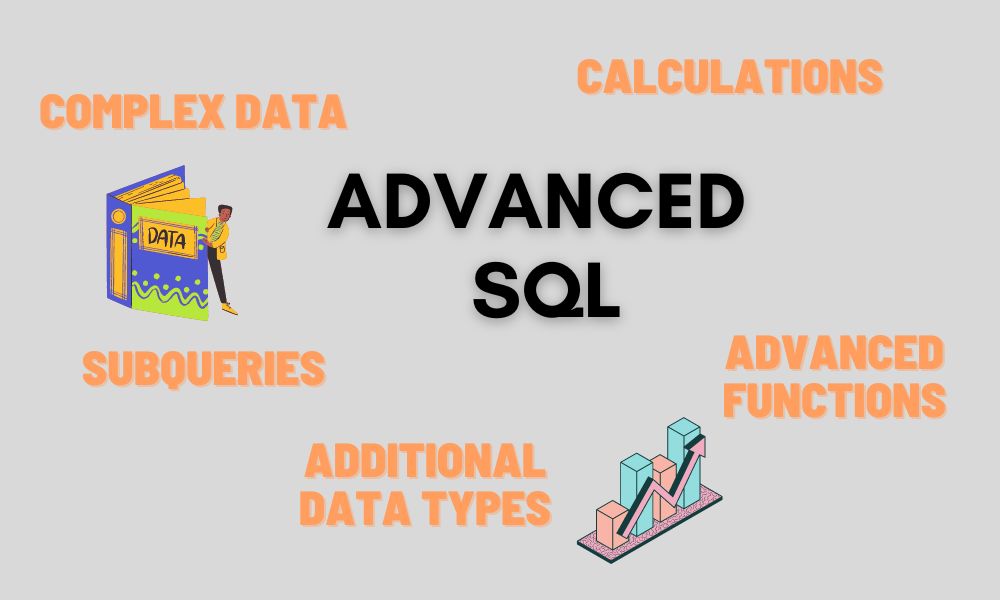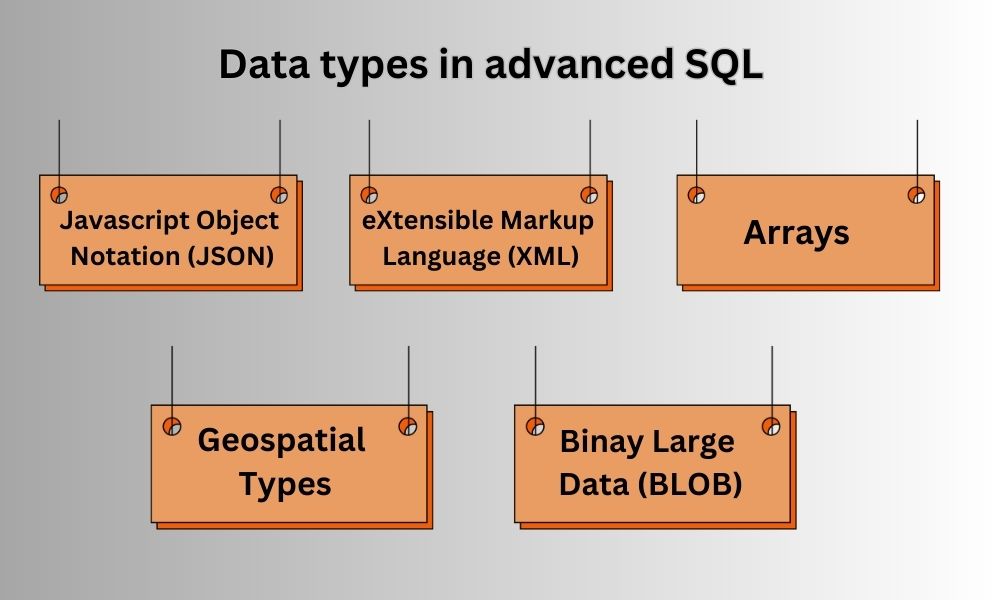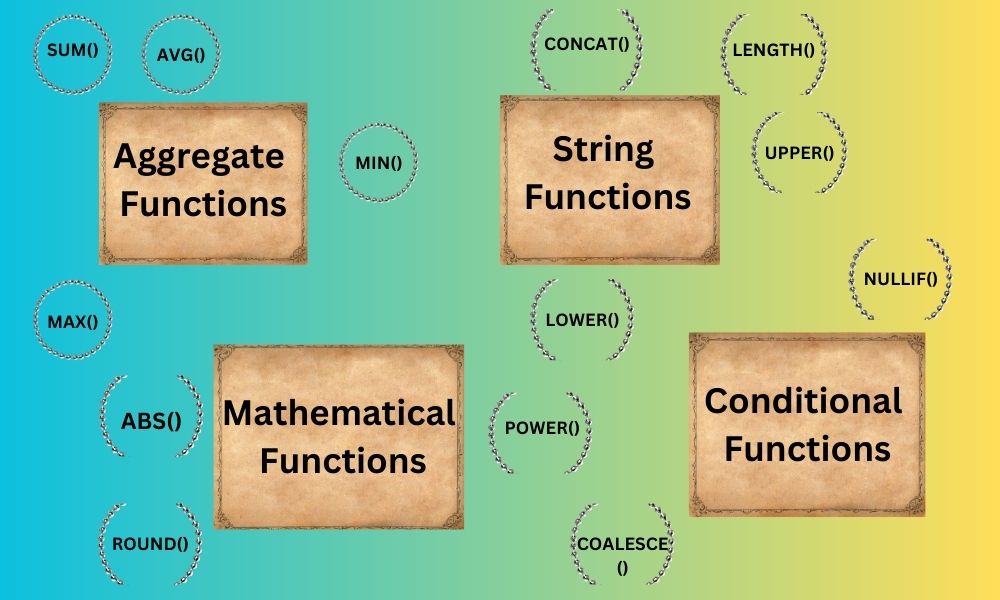Basic SQL provides a strong foundation to work with the databases, like inserting, selecting, retrieve the data, whereas advanced SQL in DBMS helps in extending the capabilities of the SQL and thus provides more sophisticated techniques, features and functions to work with complex data.
Let’s learn more about Advanced SQL in DBMS.
What is Advanced SQL?
Advanced SQL, basically refers to the use of sophisticated and complex features and techniques in the SQL or Structured Query Language, that is used to perform more intricate and powerful operations in the database.
Advanced SQL is used to handle complex data through its advanced concepts and many high capabilities of SQL.
What are the Key Components of Advanced SQL?
Here is the list of the Key Components of Advanced SQL.
- Subqueries: Queries within the queries are called subqueries. It simply means that the queries are nested in other queries. In Subqueries, the result or the output of one query is used as the input of another query. It provides more flexibility and thus enables more complex data manipulation and retrieval. Subqueries can be used with INSERT, SELECT, DELETE and UPDATE statements.
- Joins: Join function is used to combine the data from multiple tables based on particular attributes. It is used to retrieve data from multiple tables based on specific conditions. It gives a more comprehensive and meaningful result. There are many types of joins such as INNER JOIN, RIGHT JOIN, LEFT JOIN and FULL JOIN.
- Window Functions: These functions are used to perform complex calculations across a set of rows that are related to the row chosen in the current. It is used for specific ordering and partitioning of the dataset. They usually operate on the windows of the data. Some of the Windows functions are ranking, moving averages, cumulative sums, etc. These are used for performing advanced analytical functions.
- Views: These are called virtual tables, and are made or derived from the output of the query. It is used to restrict sensitive and personal information and present the data in a more user-friendly format.
- Indexing and Optimization of Performance: In Advanced SQL, also involves optimizing and understanding the performance of the queries in the database. The techniques involved in this are the creation of the appropriate indexes in the table, to analyze the performance of the query using some tools like Query Profiler or EXPLAIN. It also helps in optimizing the query execution plans.
- Common Table Expressions (CTEs): Within a SQL statement, CTEs provide a way through which temporary named results can be defined. So, the complex big queries are broken into smaller modules into parts that are more manageable and thus improve maintainability and readability. It can be used to handle complex data structures and enable hierarchical queries and thus can be recursive.
- Advanced-Data Manipulation: In Advanced SQL, Advance Data manipulation includes performing advanced operations such as INSERT AND SELECT, UPDATE AND FROM, DELETE AND FROM, etc. Based on the result of the join operations and subqueries, these functions perform and give more accurate data sets.
Data Administrators and Developers can perform more complex operations with data, and optimize the performance by using these components of the advanced SQL. It can also help in creating more scalable and efficient database solutions.
Read about: Relational Model in DBMS
What are the additional data types in advanced SQL?
In advanced SQL, there are some additional data types apart from the common or basics one that is mostly found in almost most of the database. These additional data types often provide more flexibility in managing complex data and information.
Let’s see the list of some additional data types of the advanced SQL.
- Javascript Object Notation (JSON): It is used to represent structured data. Advanced SQL has native support for the JSON data type. It allows storage, query, retrieval and manipulate the JSONser documents directly in the database. This is used for handling hierarchical and semi-structured data.
- eXtensible Markup Language (XML): It is a markup language that is used for structuring and representing data. XML Data type is supported in some of the advanced SQL databases. This plays a major role when the data is being extracted from external systems or from some of the web services that must be using XML as the format for data.
- Arrays: It is the collection of multiple values of the same data types. It provides efficient storage as retrieval of multiple related values happens at a time. Examples are an array of integers, lists of tags, etc.
- Geospatial Types: It is designed in such a manner that can represent and query the geographical information. Some advanced SQL databases can store and manipulate geographical data that includes points, lines, polygons, and spatial indexes.
- Binay Large Data (BLOB): This data type is used for storing very large data objects such as images, videos, or documents. Advanced SQL supports BLOB data type and can handle large data retrieval and manipulation easily. It uses some specialized functions to perform any type of operation.
These additional data types may vary from the types of databases being used. These data types are not supported by all the DBMSs.
Know more about DBA: Classification of DBMS Users
What are the functions in advanced SQL?
Advanced SQL supports many varieties of functions that are beyond the basics of string and arithmetic manipulation functions.
Let’s see the list of the functions supported by Advanced SQL.
1) Aggregate Functions: It is used to perform calculations on a set of values but return a single result. Some of the examples are:
- SUM(): It is used to calculate the sum of the set of values in the query.
- AVG(): It is used to calculate the average of the set of values in the query.
- COUNT(): It is used to count the number of rows or all the not null values from the set of values given.
- MAX(): It is used to find the maximum value from the set of values.
- MIN(): It is used to find the minimum values from the set of values.
2) String Functions: It operates on the character data, and is used for analyzing and manipulating the string values. Some of the examples are:
- CONCAT(): It is used for combining two or more strings.
- LENGTH(): It is used to calculate the length of the given string.
- SUBSTRING(): It is used to extract the specific portion from the given string.
- UPPER(): It is used to convert the string to the Upper case.
- LOWER(): It is used to convert the string to the Lower case.
- TRIM(): It is used to remove the trailing and the leading spaces from the string.
3) Mathematical Functions: Some mathematical functions are also included in the advanced SQL, that are used to perform some advanced complex calculations. Some of the examples are:
- ABS(): It is used to get the absolute value of a number.
- ROUND(): It is used to round the given decimal value to the closest whole number.
- POWER(): It is used to raise a number to the specific power.
- SQRT(): It is used to calculate the square root of the given number.
- LOG(): It is used to calculate the logarithm of the given number.
4) Conditional Functions: It is used to return the specific results based on the conditions applied. Some of the examples are:
- CASE WHEN THEN END: It is used to evaluate the multiple conditions using the CASE WHEN statement, and give the specific result based on the conditions. It is similar to the IF ELSE statements of the other programming language.
- NULLIF(): It is used to compare two more expressions and returns null if the expressions are equal otherwise returns the first expressions.
- COALESCE(): It is used to return the first not null values from the list of arguments passed.
Know more about Basic Introduction to SQL
Advanced SQL has a variety of powerful features that can be used by database administrators, or developers to manipulate and retrieve complex data most easily. It also offers a wide range of functions which helps perform various types of calculations with large data and it is thus very helpful for business users.


